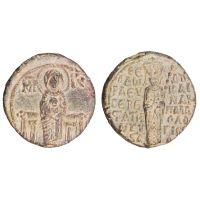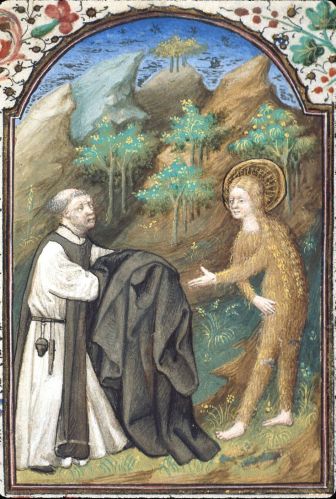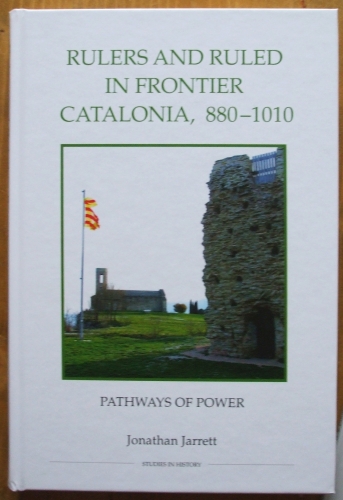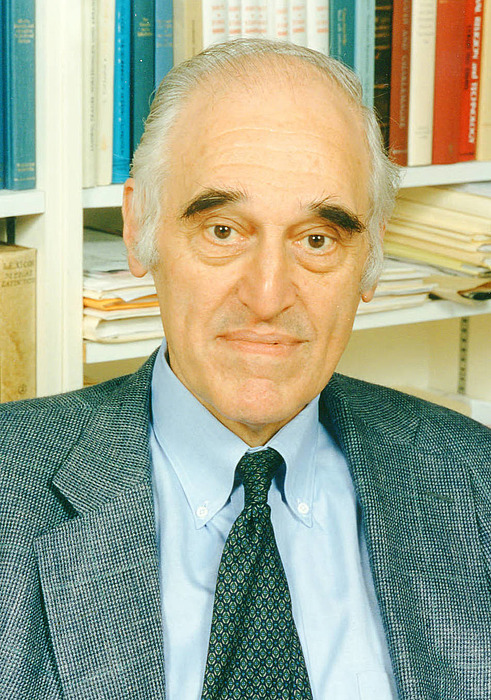Hullo again! Firstly, I should apologise for the unexpected skip week, which I can best explain as backwash from the end of the industrial action at Leeds; everything is now back at full power in our educational machine and I disappeared briefly back into the gears… But, on taking stock of where I was in my blog backlog, it turned out that for a while it was almost all papers I’d heard in Leeds at the end of 2020 or early 2021. And it’s worth remembering that there are reasons to be an academic in the UK system, for all the trouble it’s in, and that if you’re a medievalist Leeds’s name is still famous for some of those reasons. So I thought I’d showcase four of those papers here, and maybe do some more slightly later on.
So we start on 17th November 2020, when our then-resident Teaching Fellow Dr James Doherty, who is now helping to run things at Birmingham, spoke to the Institute of Medieval Studies Seminar with the title, “Count Hugh of Troyes and his Charters”. Jamie has for a long time been working on people who went on crusade when there wasn’t one of the big, numbered, crusades happening, of which there were many – he works on a project with a database you can look at – but Hugh doesn’t quite fit the profile, because he was to begin with a person who stayed home when others went, including two of his brothers, who died on crusade in 1100 and 1102. Now, if you’ve heard of Hugh at all it’s probably either because you’re Charles West (or one of his readers) or for bad reasons that Jamie should get to tell people about himself; but he was big news in his day: by various channels of inheritance he ended up running much of the future Champagne; he married a daughter of the King of France in 1095 and then lost her in an annulment in 1104; he donated Clairvaux to the Cistercian Order, ensuring that Bernard of Clairvaux would have somewhere to be of; he survived an assassination attempt in 1102; and he finally joined the Templar Order.1 And this, you know, is all notable.
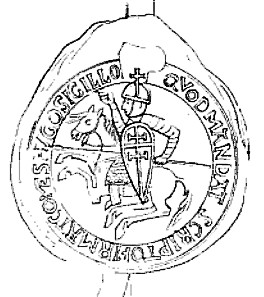
Impression of the seal of Count Hugh I of Troyes, image from Anne François Arnaud, Voyage archéologique et pittoresque dans le département de l'Aube et dans l'ancien diocèse de Troyes, Public Domain, via Wikimedia Commons
The failed marriage, however, presumably coming on the back of his loss of his brothers, seems at first to have been some kind of turning point for Hugh: he went east himself for three years in 1104, went again in 1114-1116 and then lastly, as a Templar, in 1124-1127 and possibly until his death in 1130. Some of that has been studied, but Jamie was looking at the bits of his life where he stayed home to find out what he did there. And part of the answer is that, at least for the First Crusade, he was working for Pope Urban II, settling cases to do with the properties of those who had gone on Crusades, trying to get donations completed that crusaders had made and not finished before they went, and also representing Urban’s candidature for the papacy in an area whose bishops largely did not recognise it (because people, and especially students, tend to forget that the pope who called the First Crusade was in France because he couldn’t get into Rome because of the rival, more successful, pope who was there already). Therefore, argued Jamie, instead of envisaging a dramatic change of heart from a man who had hitherto resisted the call to go east, we might see his departure in 1104 as a man who was finally free to follow his heart in a matter where he was already committed. And that seemed fair enough to me, although I did wonder whether he was also trying to make up for his brothers’ failure somehow. The documents, sadly, don’t give us that kind of perspective, but Jamie showed us that they do add something.
Jumping chronology slightly so as to stay on a theme, on 14th January 2021 the Northern Network for the Study of the Crusades met at Leeds, and I made it to that too, not least because the second speaker was someone who had taken part in my Rethinking the Medieval Frontier project a while before and I wanted to show solidarity. That was Professor Nicholas Paul, who was up second, but preceding him was Louis Pulford, speaking to the title “‘I can give no better or more authentic account of this’: the sources and intellectual context of Peter of les Vaux-de-Cernay’s Historia Albigense“. For those not familiar with that text, of whom I was one, Mr Pulford described it as a Cistercian preaching history of the Albigensian Crusade, which was directed not against Muslims but against the kind-of-Christian Cathar sect of southern France, the text being written very soon after 1219.2 Peter was nephew of the abbot of the place where he was a monk, but both were crusaders, having been on the disastrous 4th Crusade until its attack on Croatian Zara, and the abbot had also been in Cathar territory as a counter-preacher, with Peter sometimes there too, so this is a sort of religious soldier’s narrative. The text has been dismissed as being basically calqued from much older theology, however, and so is not reckoned much use as an account of the Cathars, and so Mr Pulford wanted to do a proper analysis on it to see just what texts it used and where it didn’t. There turn out to be lots, from the Bible through to Peter’s own day, including several papal letters (recorded as such), and Mr Pulford thought that the mass of this material, including some stuff from quite high up the command chain of the Crusade, might actually imply a role as official historian of it. I think I’d want a writer to say that if it was true – and why would you hide it? – so I asked and it turns out that it is dedicated to Pope Innocent III, but does not name him as sponsor. So my personal jury remains out on that, but at least this was a set of reasons to think that Peter was doing something quite specific with his text, and that its purpose might be worth divining as a source of understanding of the politics around the crusade in itself.

The ruins of Byblos Castle, in modern Lebanon, a possible setting for crusader performance! Image by Heretiq – Own work, licensed under CC BY-SA 2.5, via Wikimedia Commons
After that, Professor Paul spoke to the title, “Setting the Stage: aristocratic performance and the Eastern theatre of crusading conflict”. I thought I’d heard this paper before but actually this was a revamped version with little left of the one he’d done for us. In it, he framed crusading, which we now appreciate was dangerous, very very expensive and in general not a surefire way to advance as a Christian aristocrat in the Middle Ages, as the ultimate performance of chivalry in a world where that was a competitive sport. At home you had tournaments, which were also good stages, but this was the real deal. It was also, however, a kind of Grand Tour avant la lettre, which might include visiting Constantinople, usually as a pilgrim, and of course the Holy Land itself. One would come back having seen the hearts of the Christian world and briefly, perhaps, added one way or another to the blood flowing through them. This much was cool, but not perhaps hard to see; but Professor Paul’s next step was one I recognise now from pilgrimage study, in which he argued that romances and stories of crusading became scripts for the would-be performers to follow, and that those who moved out there, knowing from such texts what they thought they should find there, were trying to perform those scripts, even in things as material as castle-building, making them sites of hospitality and giving them gardens which made it possible for them to be the fantastic eastern sites the romances had already told them of. Apparently Hildebrand of St-Omer, otherwise unknown to me, even reports that this was being done competitively with the Muslims, trying to out-east the Easterners.3 By the end of this I wanted to read Professor Paul’s book…4

View eastwards from the west end of the north aisle of the church of my local Cistercian ex-establishment, Kirkstall Abbey, a building whose purpose was pretty clearly not just estate management. The photograph is mine.
But in between all this crusading stuff, another theme you may not have spotted there popped up again, that being Cistercians! I admit that this is actually a pretty strained link, but only because when our local Cistercians expert, Professor Emilia Jamroziak, spoke to the School of History Research Seminar on 25th November 2020, with the title, “The Theory of Modernisation and the Historiography of Medieval Monasticism”, you can tell she was working a much broader theme than just one monastic order studied more for their land-use or their angriest writer than for much else.5 She started by pointing out that monasticism is a subject whose history is usually written pretty much directly from its own institutional memory, which is of course selective, but usually written about monasteries’ connections to the wider world.6 Emilia was here instead looking at how the history that is written about these institutions come from the other side of a medieval/modern divide effectively set up by the Enlightenment (or, I might say, even earlier), preventing it being seen as a ‘rational’ response to the world whereas, of course, it did make sense to the people who did it (as they fairly clearly tell us). This tends to bring the Cistercians and their famous land management out on top as looking most ‘rational’ and ‘future-minded’, when actually the future on which all these places were focused was in fact the big eternity. Even the more recent historiography has tended to start valuing monasteries as innovators or precursors of phenomena which would later become significant, like eye-glasses, book production, and so on, which is all still basically an industrialised capitalist perspective that ignores the actual religion in these religious institutions. As Emilia said in questions, this kind of thinking lets modern Protestants engage with this Catholic movement without having to engage with its spirituality, which they consider suspect. Or else, monasteries get seen as tools of Europeanisation, bringing the periphery of the North and East onto the master narrative’s progressive track for their own teleological passages towards the Enlightenment and the current world order.
I’m putting my own spin on this, for sure, but you would be able to tell even more clearly from my notes that Emilia was quite ready to tear all this down and wants a history of monasticism at least to be told in its own terms to see what that looks like. There were lots of questions, including one person asking whether we shouldn’t therefore let monks do the history-writing themselves, to which Emilia suggested that monks wouldn’t want her doing it but that an outside perspective might still be desirable. Graham Loud suggested that another problem is that our sources are most vocal when things were going wrong, making normally-functioning monasticism much harder to see than you’d expect. But most of the questions focused around the idea of a ‘linear narrative’ which Emilia wanted us to abandon. By this she meant the progress narrative of modernisation, I’m pretty sure, but the phrasing led to various people asking if non-linear narratives are possible – Bill Flynn, liturgist until recently also at Leeds, suggested that monasteries themselves tend to see the narrative running backwards, from the age of perfection to them, and I unwittingly invoked the idea of cyclical establishment, corruption and reform that gave rise to the Cistercians themselves, which offered Emilia another pattern to suggest. As far as I can see from my desk at home, Emilia is still working on the new narrative that will answer these objections, and I should really just ask her about it, though conversations on my corridor these days tend to revolve around teaching and exhaustion and get no further. But I do rather want to see it.

The corridor is along the top of this, the Parkinson Building, University of Leeds, home of the IMS. Photo by Tim Green from Bradford [CC BY 2.0], via Wikimedia Commons.
Anyway, this all gives you some idea of the kind of things which go on in the Institute for Medieval Studies when it’s not the International Medieval Congress; and there is, as I say, more where this came from! I only wish I had then been and now was contributing more to it myself…
1. For Jamie’s take, see James Doherty, “Count Hugh of Troyes and the Prestige of Jerusalem” in History Vol. 102 (Oxford 2017), pp. 874–888, DOI: 10.1111/1468-229X.12521. For Charles’s, see Charles West, “Count Hugh of Troyes and the Territorial Principality in Early Twelfth-Century Western Europe” in English Historical Review Vol. 127 (Oxford 2012), pp. 523–548, DOI: 10.1093/ehr/ces080.
2. It has for some time been available in English as Peter of les Vaux-de-Cernay, The History of the Albigensian Crusade: Peter of les Vaux-de-Cernay’s Historia Albigensis, trans. W. A. Sibly and M. D. Sibly (Woodbridge 2002).
3. I can’t find any real trace of this person (bar this), but Professor Paul cited an article which must, I think, have been Uri Zvi Shachar, “Enshrined Fortification: A Trialogue on the Rise and Fall of Safed” in Medieval History Journal Vol. 23 (Cham 2020), pp. 265–290, DOI: 10.1177/0971945819895898. That said, the details don’t match perfectly and the only Latin source I can see in Schachar’s citation is Laura Minervini (ed.), Cronaca del Templare di Tiro (1243-1314): La caduta degli Stati crociati nel racconto di un testimone oculare (Napoli 2000), and I can’t find much out about that either. But that’s as far as I think it’s probably sensible to chase this particular hare…
4. It is Nicholas L. Paul, To Follow in Their Footsteps The Crusades and Family Memory in the High Middle Ages (Ithaca NY 2012).
5. Although if you are interested in Cistercians, obviously we at Leeds recommend Emilia Jamroziak, The Cistercian Order in Medieval Europe, 1090-1500 (London 2013), and Jamroziak, “East-Central European Monasticism: Between East and West?” in Alison I. Beach and Isabelle Cochelin (edd.), The Cambridge History of Medieval Monasticism in the Latin World (Cambridge 2019), 2 vols, vol. II pp. 882–900, is also important more generally, as is lots more of Emilia’s work.
6. I have to admit guilt here: this is exactly what Jonathan Jarrett, “Power over Past and Future: Abbess Emma and the nunnery of Sant Joan de les Abadesses” in Early Medieval Europe Vol. 12 (Oxford 2003), pp 229–258, DOI: 10.1111/j.0963-9462.2004.00128.x, does, though in my defence Jarrett, “Nuns, Signatures, and Literacy in late-Carolingian Catalonia” in Traditio Vol. 74 (Cambridge 2019), pp. 125–152, DOI: 10.1017/tdo.2019.7, is more like what Emilia suggests, so in this sense I have developed.







